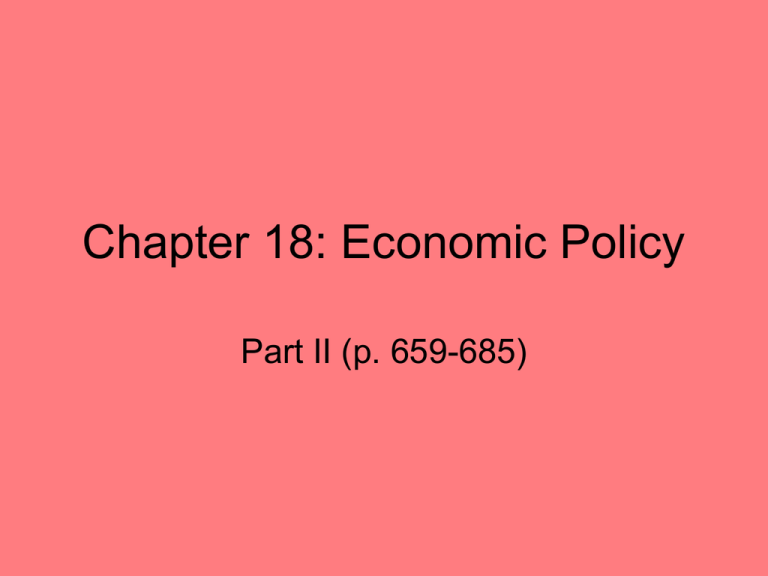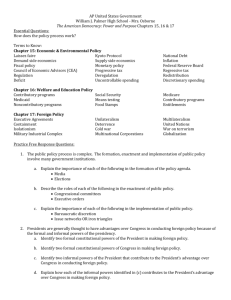Chapter 18: Economic Policy
advertisement

Chapter 18: Economic Policy Part II (p. 659-685) Monetary Policy: Controlling the Money Supply • Monetary Policy – A form of government regulation in which the nation’s money supply and interest rates are controlled • Money – A system of exchange for goods and services that includes currency, coins and bank deposits • Federal Reserve: Board of Governors – A seven-member board that sets member banks’ reserve requirements, controls the discount rate, and makes other economic decisions Monetary Policy: Controlling the Money Supply • Reserve requirements – Governmental requirements that a portion of member banks’ deposits must be retained to back loans made • Discount rate – The rate of interest at which member banks can borrow money from their regional Federal Reserve Bank • Open Market Operations – The buying and selling of government securities by the Federal Reserve Bank in the securities market The FRB and the Executive and Legislative Branches • President shares responsibility for fiscal policy with Congress • Congress authorizes the FRB to make monetary policy • But there are many formal and informal contacts between the White House and the FRB Fiscal Policy: Taxing and Spending • Fiscal policy: – Federal government policies on taxes, spending, and debt management – Intended to promote the nation’s macroeconomic goals, particularly with respect to employment, price stability, and growth • Keynesian theory • Discretionary fiscal policy: deliberate decisions by the president and Congress to run budget surpluses or deficits – John F. Kennedy first to apply fiscal policy theory • Revenue Act of 1964 – Reduced personal and corporate income tax rates • Tax cuts to stimulate the economy – Reagan in 1981 and G.W. Bush in 2001 and 2003 The Effects of Globalization • International economy – Increased competition benefits consumers – Expands the market for American products – Labor unions are strongest critics of free trade • Stress need to restrict “dumping” • Fair trade rather than free trade – Analysis suggests that globalization further segments the market into winners and losers. • Losers tend to be smaller businesses and workers. The Budgetary Process • Federal government raises money from: – – – – Individual income taxes Social insurance Retirement receipts Corporate income taxes make up less than 10 percent of receipts • Most government spending goes toward: – National defense – Human resources Congress and the Budgetary Process • Budget and Accounting Act of 1921 – Gave the president authority to prepare an annual budget and submit it to Congress • Staff agency now called the Office of Management and Budget was created to assist the president in this process • President sends budget proposal to Congress in January or February of each year • Congress and the appropriations committees actually provide the funding needed to carry out programs. – Budget and Impoundment Control Act of 1974 The Budget Deficit and the Debt • Federal budget deficit – The amount by which federal expenditures exceed federal revenues • Gross domestic product (GDP) • The total market value of all goods and services produced in a country during a year • Deficit reduction legislation – Gramm-Rudman-Hollings Act of 1985 – Budget Enforcement Act of 1990 • Budget surplus 1998 – Balanced Budget: the revenue meets or exceeds costs The Economics of Environmental Regulation • Since the 1970s, Congress has enacted a large volume of pollution control legislation. • Clean Air Act • Clean Water Act • Toxic Substance Control Act • Implementation of these laws rests primarily with the Environmental Protection Agency. The Environmental Protection Agency • Nation’s largest regulatory agency – Works with state agencies to enforce environmental legislation • Three major eras of EPA’s political life – 1970s: organizational growth – 1980s: Reagan administration and hostility toward EPA goals; budget cuts – 1983 onward: increase in budget and staff; focus on balance between environmental protection and economic costs








